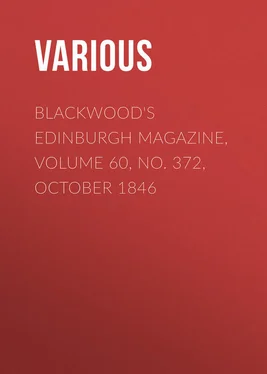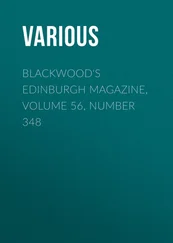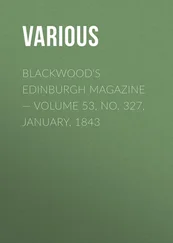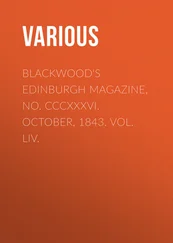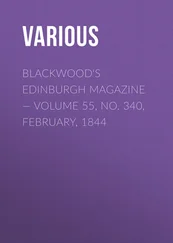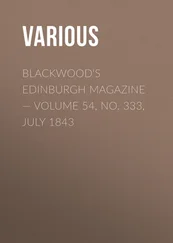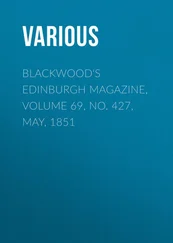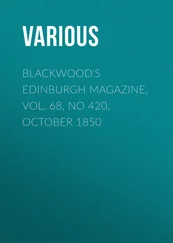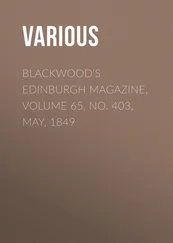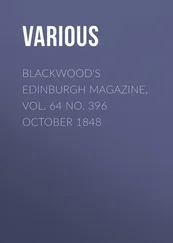Various - Blackwood's Edinburgh Magazine, Volume 60, No. 372, October 1846
Здесь есть возможность читать онлайн «Various - Blackwood's Edinburgh Magazine, Volume 60, No. 372, October 1846» — ознакомительный отрывок электронной книги совершенно бесплатно, а после прочтения отрывка купить полную версию. В некоторых случаях можно слушать аудио, скачать через торрент в формате fb2 и присутствует краткое содержание. Издательство: Иностранный паблик, Жанр: periodic, foreign_edu, Путешествия и география, на английском языке. Описание произведения, (предисловие) а так же отзывы посетителей доступны на портале библиотеки ЛибКат.
- Название:Blackwood's Edinburgh Magazine, Volume 60, No. 372, October 1846
- Автор:
- Издательство:Иностранный паблик
- Жанр:
- Год:неизвестен
- ISBN:нет данных
- Рейтинг книги:3 / 5. Голосов: 1
-
Избранное:Добавить в избранное
- Отзывы:
-
Ваша оценка:
- 60
- 1
- 2
- 3
- 4
- 5
Blackwood's Edinburgh Magazine, Volume 60, No. 372, October 1846: краткое содержание, описание и аннотация
Предлагаем к чтению аннотацию, описание, краткое содержание или предисловие (зависит от того, что написал сам автор книги «Blackwood's Edinburgh Magazine, Volume 60, No. 372, October 1846»). Если вы не нашли необходимую информацию о книге — напишите в комментариях, мы постараемся отыскать её.
Blackwood's Edinburgh Magazine, Volume 60, No. 372, October 1846 — читать онлайн ознакомительный отрывок
Ниже представлен текст книги, разбитый по страницам. Система сохранения места последней прочитанной страницы, позволяет с удобством читать онлайн бесплатно книгу «Blackwood's Edinburgh Magazine, Volume 60, No. 372, October 1846», без необходимости каждый раз заново искать на чём Вы остановились. Поставьте закладку, и сможете в любой момент перейти на страницу, на которой закончили чтение.
Интервал:
Закладка:
Why, this is the very Eden of a sportsman! Flesh, fowl, and fish of every description in abundance, and such endless variety, that no month of the year can pass over without affording its quota of fair and legitimate recreation. But to a man of Mr St John's accomplishment and observant habits, the mere prey is a matter of far less moment than the insight which such a locality affords, into the habits and instincts of the creatures which either permanently inhabit or casually visit our shores. His journal is far more than a sportsman's book. It contains shrewd and minute observations on the whole of our northern fauna – the results of many a lonely but happy day spent in the woods, the glens, the sand-tracts, by river and on sea. His range is wider than that which has been taken either by White of Selborne, or by Waterton; and we are certain that he will hold it to be no mean compliment when we say, that in our unbiased opinion, he is not surpassed by either of them in fidelity, and in point of picturesqueness of description, is even the superior of both. The truth is, that Mr St John would have made a first-rate trapper. We should not have the slightest objections to lose ourselves in his company for several weeks in the prairies of North America; being satisfied that we should return with a better cargo of beaver-skins and peltry than ever fell to the lot of two adventurers in the service of the Company of Hudson's Bay.
It is totally impossible to follow our author through any thing like his range of subjects, extending from the hart to the seal and otter, from the eagle and wild swan to the ouzel. One or two specimens we shall give, in order that you, our dear and sporting reader, may judge whether these encomiums of ours are exaggerated or misplaced. We are, so say our enemies, but little given to laudation, and far too ready when occasion offers, and sometimes when it does not, to clutch hastily at the knout. You, who know us better, and whom indeed we have partially trained up in the wicked ways of criticism, must long ago have been aware, that if we err at all, it is upon the safer side. But be that as it may, you will not, we are sure, refuse to join with us in admiring the beauty of the following description; – it is of the heronry on the Findhorn – a river of peculiar beauty, even in this land of lake, of mountain, and of flood.
"I observe that the herons in the heronry on the Findhorn are now busily employed in sitting on their eggs – the heron being one of the first birds to commence breeding in this country. A more curious and interesting sight than the Findhorn heronry I do not know: from the top of the high rocks on the east side of the river you look down into every nest – the herons breeding on the opposite side of the river, which is here very narrow. The cliffs and rocks are studded with splendid pines and larch, and fringed with all the more lowly but not less beautiful underwood which abounds in this country. Conspicuous amongst these are the bird-cherry and mountain-ash, the holly, and the wild rose; while the golden blossoms of furze and broom enliven every crevice and corner in the rock. Opposite to you is a wood of larch and oak, on the latter of which trees are crowded a vast number of the nests of the heron. The foliage and small branches of the oaks that they breed on seem entirely destroyed, leaving nothing but the naked arms and branches of the trees on which the nests are placed. The same nests, slightly repaired, are used year after year. Looking down at them from the high banks of the Altyre side of the river, you can see directly into their nests, and can become acquainted with the whole of their domestic economy. You can plainly see the green eggs, and also the young herons, who fearlessly, and conscious of the security they are left in, are constantly passing backwards and forwards, and alighting on the topmost branches of the larch or oak trees; whilst the still younger birds sit bolt upright in the nest, snapping their beaks together with a curious sound. Occasionally a grave-looking heron is seen balancing himself by some incomprehensible feat of gymnastics on the very topmost twig of a larch-tree, where he swings about in an unsteady manner, quite unbecoming so sage-looking a bird. Occasionally a thievish jackdaw dashes out from the cliffs opposite the heronry, and flies straight into some unguarded nest, seizes one of the large green eggs, and flies back to his own side of the river, the rightful owner of the eggs pursuing the active little robber with loud cries and the most awkward attempts at catching him.
"The heron is a noble and picturesque-looking bird, as she sails quietly through the air with outstretched wings and slow flight; but nothing is more ridiculous and undignified than her appearance as she vainly chases the jackdaw or hooded crow who is carrying off her egg, and darting rapidly round the angles and corners of the rocks. Now and then every heron raises its head and looks on the alert as the peregrine falcon, with rapid and direct flight, passes their crowded dominion; but intent on his own nest, built on the rock some little way further on, the hawk takes no notice of his long-legged neighbours, who soon settle down again into their attitudes of rest. The kestrel-hawk frequents the same part of the river, and lives in amity with the wood-pigeons that breed in every cluster of ivy which clings to the rocks. Even that bold and fearless enemy of all the pigeon race, the sparrowhawk, frequently has her nest within a few yards of the wood-pigeon; and you see these birds (at all other seasons such deadly enemies) passing each other in their way to and fro from their respective nests in perfect peace and amity. It has seemed to me that the sparrowhawk and wood-pigeon during the breeding season frequently enter into a mutual compact against the crows and jackdaws, who are constantly on the look-out for the eggs of all other birds. The hawk appears to depend on the vigilance of the wood-pigeon to warn him of the approach of these marauders; and then the brave little warrior sallies out, and is not satisfied till he has driven the crow to a safe distance from the nests of himself and his more peaceable ally. At least in no other way can I account for these two birds so very frequently breeding not only in the same range of rock, but within two or three yards of each other."
Now for the wild swan. You will observe that it is now well on in October, and that the weather is peculiarly cold. There is snow already lying on the tops of the nearer hills – the further mountains have assumed a coat of white, which, with additions, will last them until the beginning of next summer; and those long black streaks which rise upwards, and appear to us at this distance so narrow, are, in reality, the great ravines in which two months ago we were cautiously stalking the deer. The bay is now crowded with every kind of aquatic fowl. Day after day strange visitants have been arriving from the north; and at nightfall, you may hear them quacking and screaming and gabbling for many miles along the shore. Every moonlight night the woodcock and snipe are dropping into the thickets, panting and exhausted by their flight from rugged Norway, a voyage during which they can find no resting-place for the sole of their foot. In stormy weather the light-houses are beset with flocks of birds, who, their reckoning lost, are attracted by the blaze of the beacon, dash wildly towards it, as to some place of refuge, and perish from the violence of the shock. As yet, however, all is calm; and lo, in the moonlight, a great flight of birds stooping down towards the bay! – noiselessly at first, but presently, as they begin to sweep lower, trumpeting and calling to each other; and then, with a mighty rustling of their pinions, and a dash as of a vessel launched into the waters, the white wild-swans settle down into the centre of the glittering bay! To your tents, ye sportsmen! for ball and cartridge; and now circumvent them if you can.
Читать дальшеИнтервал:
Закладка:
Похожие книги на «Blackwood's Edinburgh Magazine, Volume 60, No. 372, October 1846»
Представляем Вашему вниманию похожие книги на «Blackwood's Edinburgh Magazine, Volume 60, No. 372, October 1846» списком для выбора. Мы отобрали схожую по названию и смыслу литературу в надежде предоставить читателям больше вариантов отыскать новые, интересные, ещё непрочитанные произведения.
Обсуждение, отзывы о книге «Blackwood's Edinburgh Magazine, Volume 60, No. 372, October 1846» и просто собственные мнения читателей. Оставьте ваши комментарии, напишите, что Вы думаете о произведении, его смысле или главных героях. Укажите что конкретно понравилось, а что нет, и почему Вы так считаете.
